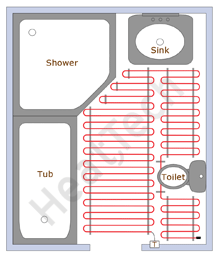Radiant Floor Heating Cable

 Features:
Features:
- 120V systems: Up to 600ft of cable per thermostat.
- 240V systems: Up to 1200ft of cable per thermostat.
- A single 10ft long armored cold lead means no excess wires to run.
- Output as high as 12W per sq. ft (at 3” cable spacing - recommended).
- Heating cable is only ~1/8” thick.
- All thermostats and floor heating cable are UL/ETL listed for USA & Canada.
Ideal for: Bathrooms, Kitchens, Shower Beds, Saunas, etc. Well suited for new projects and renovation.
Works with: Tile, Stone, Laminate, Granite, Vinyl, Engineered Wood Floors and others.
Tutorials: How to size and select proper length of floor heating cable.
Electric radiant floor heating cable by HeatTech offers an easy, affordable and versatile solution for a wide range of project types.Unlike mats, radiant heating cable is not restricted by the boundaries of the fiberglass mesh, allowing it to be more versatile in installation, including being bent along curves and around corners as needed. Spacing the heating cable at 2", 3" (recommended) or 4" apart also allows to control the amount of heat output by the system, improving performance in colder or warmer climates.
While installing HeatTech cable generally involves more labor compared to mats, the overall process can be made easier by using HeatTech Cable Guides.
Cable Guides are rolls of thin metallic strip with hooks for heating cable equally spaced at 1" apart. This spacing allows installer to secure the electric radiant floor heating cable precisely at 2", 3" or 4" apart, ensuring the even heat distribution, and making Cable Guides a much better alternative to adhesive tape.
Using multiple runs of electric radiant floor heating cable
It may be necessary to use 2 or more runs of heating cable for a single zone (single thermostat) if the total length of cable required for the project exceeds 400ft (max. length available), but not exceeds 600ft (max length allowed per thermostat).Above only applies to large heated areas, typically over 100 sq. ft. Since a single floor sensing thermostat is capable of handling a maximum combined load of 15 Amps, the total combined Amp load (see tables above for data) of cables should not exceed 15A, which translates into 600ft of floor heating cable. For systems with 3” spacing, this equates into 150 sq. ft of heated space, whereas for 4” cable spacing – 200 sq. ft of heated space.
It is also possible to use a combination of electric radiant floor heating cable and mats, where mats cover the major square areas, while cable is laid out in areas containing angles, curves and small spaces.
Selecting the right thermostat
Choose the best - all floor sensing thermostats we offer are either Honeywell (Aube) or OJ Microline brands, both of which set the industry standard and are known to be top quality, safe and reliable. Popular models we carry include:Honeywell/Aube TH115-AF-120S - regular 120V model
Honeywell/Aube TH115-AF-240S - regular 240V model
Honeywell/Aube TH115-AF-GA - model w/ built-in 5mA GFCI (120/240V dual voltage compatible)
OJ Microline UDG-4999 - model w/ built-in 5mA GFCI (120/240V dual voltage compatible)
Programmability - an important feature, used to control the on/off cycling of the system to maintain desired temperature level. Efficient operation of the system may result in power savings in the 10-30% range compared to non-programmable thermostats.
Floor sensing ability - for a proper operation and quick system response, a floor sensing thermostat is required. Standard (non - floor-sensing) thermostats are designed to sense the ambient air temperature (room air temperature) instead of floor temperature and therefore will delay system start-up even if floors are cold and its’ shutdown even when the floors are warm.
Built-in GFCI safety (available only on GFCI models) - this safety feature is required for installation in humid & wet areas, such as mud rooms, bathrooms and kitchens and offers top-level protection against electrical shock as a result of compromised electrical cable.
Using a backup floor sensor
While sensors we sell are time-tested and are designed to last as long as the heating system itself, having a secondary sensor installed in proximity to the main one would eliminate system downtime and labor needed to replace it, in the unlikely event of failure. If a secondary sensor is not installed, it would be best to run the first one in a conduit pipe, rather than directly buried in cement - to facilitate removal and replacement.Literature

HeatTech Cable - Installation Manual (pdf)

TH115-AF-120S and TH115-AF-240S - Installation Manual (pdf)

TH115-AF-GA - Installation Manual (pdf)
